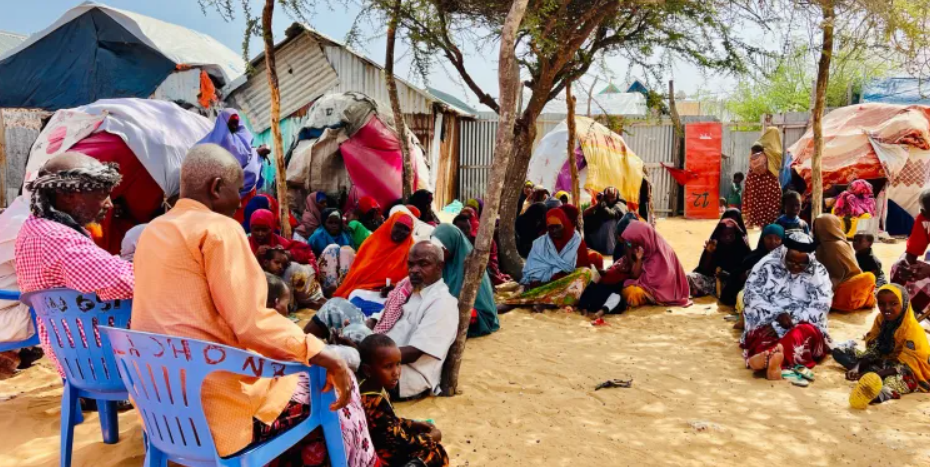By Hinda Abdi Mohamoud – Chief Editor, Bilan Media
MOGADISHU –
As Somalia continues to suffer from relentless droughts, floods, and armed conflict, more and more people are being forced to leave their rural homes for urban centers — especially the capital, Mogadishu. The United Nations estimates that by 2026, more Somalis will live in cities than in rural areas. Mogadishu, now one of the fastest-growing cities in the world, is absorbing huge numbers of displaced people — 79% of whom are women and children.
According to a report by Refugees International, most of Somalia’s internally displaced people (IDPs) are unlikely to return home. Some have lived in displacement camps for more than 30 years.
Of the country’s 4.3 million IDPs, many come from farming and pastoralist backgrounds and are now forced to find new ways to survive in urban settings where their skills have little value.
Fatima Mohamed Iise, 31, arrived at the newly formed Asal IDP camp on Mogadishu’s outskirts in June 2023 with her seven children. She had fled Qoryoley district in Lower Shabelle after drought wiped out all her livestock. Her husband remained behind to protect their few remaining possessions.
“We had a good life as pastoralists — about 40 cows,” she said. “Now we have none, so I had no choice but to come to Mogadishu with my children.”
There was no aid available when she arrived. In desperation, she followed advice from other women and began looking for work in nearby neighborhoods.
“My nine-year-old daughter and I leave early every morning to find work. The only jobs available are laundry and cleaning construction sites, which pay $1 to $1.50 a day. It’s not enough, but it’s something.”
With no urban skills, IDPs like Fatima must start from scratch. Residents of Asal camp seek informal labor daily — mostly cleaning homes, restaurants, or washing clothes. Children as young as four work alongside their parents, washing dishes or shining shoes. Incomes of $1–$2 a day leave families trapped in poverty.
“We eat once a day at lunchtime,” said Fatima. “The rest of the time, we just drink tea. Sometimes we go to sleep hungry.”
Beyond poverty, displaced women face widespread harassment — particularly from security forces, camp officials, and others in positions of power. Rape and exploitation are rampant in shelters built from plastic sheets and sticks, which offer no protection. In exchange for food or jobs, men often demand sexual favors.
“Men offer to help me find work or food,” Fatima said. “But then they ask for sex or want to marry my daughters.”
“No Sex, No Food”
Hawa*, 70, lives in Asal camp with her three-year-old granddaughter. She initially received food aid — until she refused sexual advances from a camp manager.
“He told me directly — no sex, no food,” she said. “Since I rejected him, I haven’t received a single grain of food.”
She now seeks work daily, sometimes bringing her granddaughter along. Others watch the child when she can’t.
S’iido Hassan Moalim, 66, lives alone in the same camp. A former nomad from Kuntuwaarey, she is nearly blind, unmarried, and has no children.
“I believe I am the poorest in this camp,” she said. “I can’t see, I can’t work, and I’ve never received any food aid. The weak have no rights here.”
She refuses to compromise her dignity in exchange for help.
“Camp officials help only those who give in to their demands. I’m too old, and I respect my culture — I can’t do that.”
Daily Exploitation
Iisho Mukhtar Adam arrived in June 2023 with her three sons. She immediately began working as a cleaner.
“I work long hours cleaning homes or doing laundry,” she said. “I earn $1–$2 a day. Sometimes employers refuse to pay or accuse us of stealing.”
Police are often too busy with security threats or are corrupt. Adam has little hope for justice.
“No one listens to us. All we can do is speak to the media and hope someone will help.”
She has heard of sexual abuse in the camp but has not yet been targeted. Still, she is aware that speaking out may lead to eviction.
Prejudice and Marginalization
In the older Allah-dhowr IDP camp, conditions are similar. Rahma Mohamed arrived in 2022 with her husband and four children. Despite daily labor, they are often underpaid.
“We agree on $5, and they give me $3,” she said. “Still, I want to build a small business here and support my family.”
Her daughter, Asmo, 15, works with her as a maid. Children from local neighborhoods mock her for being a “village girl” who doesn’t attend school.
Even those who have lived in Mogadishu for decades are still seen as outsiders.
“I’ve lived here 16 years, but people still call me a refugee,” said Mukhtar Abdalla Abdow, 60, who fled Janaale decades ago.
Resident Sayid Omar echoed this prejudice:
“Even if they integrate into city life, I see them as second-class citizens.”
But not everyone agrees. Juweeriya Mohamed Ibrahim, another Mogadishu resident, offers a more compassionate view.
“I see them as normal people — survivors of floods, drought, and war. If they’ve lived here for five years, they’re residents just like me.”


